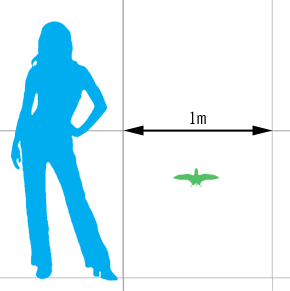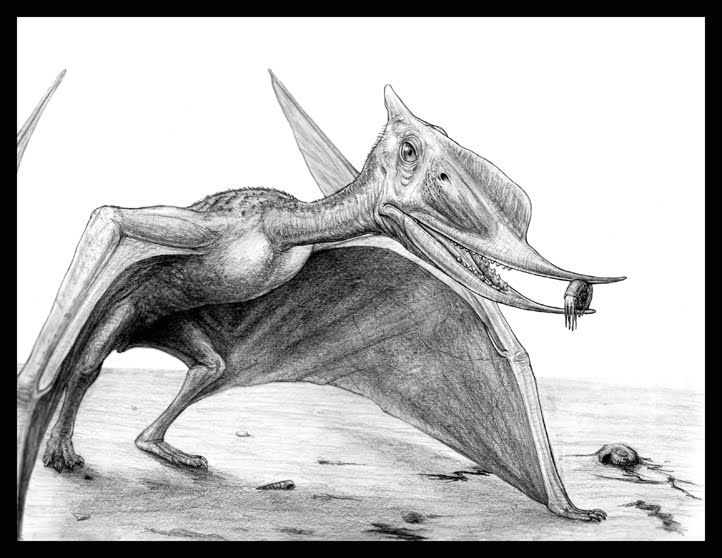[Recent Entries][Archive][Friends][User Info]
May 17th, 2014
| May 17th, 2014 | |
|---|---|
| 01:52 pm [industrialterro] [Link] |
Dendrorhynchoides Dendrorhynchoides was a genus of anurognathid pterosaur containing species known from the Early Cretaceous (early Aptian) Yixian Formation, discovered near Beipiao, Chaoyang, Liaoning, China, and from Middle Jurassic Tiaojishan Formation of Qinglong, northern Hebei Province, China. The holotype of the type species was found in the Jianshangou Bed of the Yixian Formation, dated to about 124.6 million years old. However, Lü and Hone (2012) considered it possible that the holotype of D. curvidentatus was actually found in the Middle Jurassic deposits; the authors note that all other Chinese anurognathids are Jurassic in age, and that Jeholopterus was also initially thought to be a Cretaceous taxon until subsequent studies established it to be from the Jurassic. The genus was in 1998 first named Dendrorhynchus by Ji Shu'an and Ji Qiang, but that name proved to be preoccupied by a nemertean parasitic worm named in 1920 by David Keilin. It was therefore renamed in 1999. The type species is Dendrorhynchoides curvidentatus. The genus name is derived from Greek dendron, "tree" and rhynkhos, "snout" in reference to it being assumed a tree-dweller and presumed a close relative of Rhamphorhynchus. The specific name means "curved-toothed" in Latin. A second species, D. mutoudengensis, was described in 2012. The genus is based on holotype GMV2128, a fossil originally discovered around 1995 and obtained by science from illegal fossil dealers who first prepared it. It consists of a near-complete skeleton of a subadult individual and is crushed. Most elements are present, exceptions include the sternum, the tail end, sacrals and the fourth phalanx of the wing finger. Of the type specimen, most parts of the skull have become detached so that its shape is difficult to determine, but it was generally short and broad. Eleven teeth have been preserved scattered throughout the matrix, that are recurved with a broader base and have a length of three millimetres. The authors identified lower jaws with a preserved length of fifteen millimetres. The cervical vertebrae are short and broad. Six dorsal vertebrae have been preserved, nine ribs and six belly ribs at the left side. The tail has a preserved length of five centimetres, but part of this is accounted for by a section that might have been added to enhance the value of the fossil. The tail vertebrae at the base, the authenticity of which is certain, are short. The wings are relatively short. The humerus is robustly built but elongated with a length of 27 millimetres. The ulna is 35.5 millimetres long. The metacarpals are short with seven millimetres length for the first three, 9.3 millimetres for the fourth wing-bearing metacarpal. The first three fingers are well developed with the first having an elongated first phalanx. They bear short but sharp claws. The first phalanx of the fourth, wing, finger has a length of 44.5, the second of 35.6 millimetres. The size of the third cannot be established because of damage. A short and slender pteroid, 5.9 millimetres long, points towards the elbow. The wingspan is about forty centimetres, making Dendrorhynchoides one of the smallest known pterosaurs The tibia has a length of 26.7 millimetres and is about a third longer than the femur. The fibula is reduced, reaching about half-way downwards along the tibia shaft. The foot is long with the metatarsals having a length of 12.1 millimetres. The fifth toe is elongated. Because of the presumed long tail, the authors rejected a placement within the Anurognathidae and classified it instead as a long-tailed rhamphorhynchid, mainly in view of the general long bone proportions. It was in 2000 identified as an anurognathid, and it was confirmed that the fossil had been doctored prior to its description. A cladistic analysis by Alexander Kellner in 2003 had the same outcome, Dendrorhynchoides being found to form an anurognathid clade with Batrachognathus and Jeholopterus, that he named the Asiaticognathidae. An analysis by Lü Junchang in 2006 resolved the relations even further, finding Dendrorhynchoides to be the sister taxon of clade formed by the other two asiaticognathid species. The describers postulated a tree-dwelling lifestyle for Dendrorhynchoides as an insectivore. In 2010 a second specimen, of a juvenile, was announced, that proved that a more elongated tail was present after all, albeit not so long as the faked tail of the holotype: about 85% of femur length. This specimen eventually was designated as the holotype of Dendrorhynchoides mutoudengensis. The specimen was originally stored in the Guilin Geological Museum and designated GLGMV 0002; later it was moved to the Jinzhou Paleontological Museum and designated JZMP-04-07-3. Размеры тела в сравнении с человеком:
Tags: Вымершие рептилии, Мел, авеметатарзалии, анурогнатиды, архозавроморфы, архозавры, диапсиды, птерозавры, рамфоринхоидеи |
| Time | Event |
| 03:38 pm [industrialterro] [Link] |
Domeykodactylus Domeykodactylus was a genus of dsungaripteroid pterodactyloid pterosaur from the Early Cretaceous-age Quebrada de la Carreta of Antofagasta, Chile. The genus was named in 2000 by David Martill, Eberhard Frey, Guillermo Chong Diaz and Charles Michael Bell. The type species is Domeykodactylus ceciliae. The genus name is derived from the Cordillera Domeyko and Greek daktylos, "finger" in reference to the wing finger typical of pterosaurs. The specific name honours geologist Cecilia Demargasso of the Universidad Católica del Norte, "who was so kind to us". Domeykodactylus is based on holotype Departmento de Ciencias Geológicas at the Universidad Católica del Norte, Antofagasta 250973, found in the Sierra da Candeleros. It consists of a partial mandible; a premaxilla, present in the same rock, is referred to it as paratype. The fossil had at first been thought to belong to Pterodaustro. Domeykodactylus had a crest running along the top of the premaxilla. The bone structure of the crest consists of vertical trabeculae, narrow struts; it was this texture that had originally been mistaken for the fine filter teeth of Pterodaustro. The mandible has a short symphysis. There are sixteen tooth sockets, from which the teeth themselves have been lost, in each dentary. The sockets are narrow, oval and slightly elevated, with a raised margin, above the level of the jaw. The teeth were probably small and towards the back more widely spaced and declining in size. The skull length has been estimated at thirty centimetres and the wingspan at one metre (3.28 ft). The describers found Domeykodactylus similar to both the Ctenochasmatidae and Dsungaripteridae in the crest; because of the elevated tooth sockets it was assigned to the latter group. It was the first published example of a dsungapterid in South America, most other members of the family being from Asia.
Tags: Вымершие рептилии, Мел, авеметатарзалии, аждархойды, архозавроморфы, архозавры, джунгариптероиды, диапсиды, монофенестраты, орнитохейройды, птеродактили, птерозавры |
| Previous Day | 2014/05/17 [Archive] |
Next Day |








